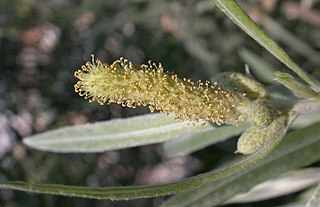
Salix exigua is a species of willow native to most of North America except for the southeast and far north, occurring from Alaska east to New Brunswick, and south to northern Mexico. It is considered a threatened species in Massachusetts while in Connecticut, Maryland, and New Hampshire it is considered endangered.

Rinodina is a genus of lichen-forming fungi in the family Physciaceae. The genus has a widespread distribution and contains about 265 species. It is hypothesized that a few saxicolous species common to dry regions of western North America, southern Europe, North Africa and central Asia may date back 240 million years to the Middle Triassic.
Pieter Groenhart was a Dutch lichenologist known for his research into tropical Asian lichens. Born in Ilpendam, he became a teacher in 1916 and taught in several local elementary schools. In 1926 he moved to Java, where he became a teacher at the Agricultural School in Malang, from 1926 to 1932. Soon after, he studied biology at the University of Utrecht (1932–1935), and then started to study lichens at the Rijksherbarium in Leiden, from 1935 to 1936. He returned to teaching in Malang until 1940, when he was transferred to a Government school at present-day Bogor.

Ashdown Park is a 9.3-hectare (23-acre) biological Site of Special Scientific Interest (SSSI) south of Ashbury in Oxfordshire. The SSSI is part of the park of Ashdown House.
Rinodina brauniana is a species of lichen in the family Physciaceae. It was described as new to science in 2019 and grows in North America in the Southern Appalachian Mountains in North Carolina, Tennessee and Alabama. It lives on the bark of deciduous trees, shrubs, and conifers. It was named in honor of Emma Lucy Braun.
Adolf Hugo Magnusson was a Swedish naturalist who specialized in lichenology. He was a school teacher in Gothenburg from 1909 to 1948, but spent his spare time on the study of lichens. He described about 900 new taxa, specializing in the genera Lecidea, Lecanora, Caloplaca, and Acarospora.

Caliciales is an order of mostly lichenized fungi in the class Lecanoromycetes. It consists of two families: Caliciaceae and Physciaceae, which together contain 54 genera and more than 1200 species. The order was circumscribed by American botanist Charles Edwin Bessey in 1907.
Orcularia is a genus of four species of lichens in the family Caliciaceae. It was originally circumscribed as a section of the genus Rinodina by Swedish botanist Gustaf Oskar Andersson Malme in 1902. Klaus Kalb and Mireia Giralt promoted it to generic status in 2011. Orcularia is characterized by the presence of ascospores that develop in such a way that the septum is inserted after lateral wall thickenings become distinct, and also by threadlike (filiform) conidia.

Amandinea milliaria is a species of corticolous lichen in the family Caliciaceae. It was originally described as a species of Rinodina by Edward Tuckerman in 1877. Philip F. May and John Wilson Sheard transferred it to Amandinea in 1997. The lichen is found in the east coast of North America, ranging from Prince Edward Island south to Texas, and includes the Great Lakes region.
Rinodina atrocinerea is a species of lichen belonging to the family Physciaceae.
Helmut Mayrhofer is an Austrian lichenologist. He is known for his expertise on the lichen family Physciaceae and his studies of the lichen flora of the Balkan Peninsula, the Alps, and other regions.
Henricus (Harrie) Johannes Maria Sipman is a Dutch lichenologist. He specialises in tropical and subtropical lichens, and has authored or co-authored more than 250 scientific publications. He was the curator of the lichen herbarium at the Berlin Botanical Garden and Botanical Museum from 1983 until his retirement in 2010.
Oxneria ussuriensis is a species of corticolous, crustose lichen in the family Teloschistaceae. It is found in a single location in the Russian Far East.
Gallowayella aphrodites is a species of corticolous (bark-dwelling), foliose (leafy) lichen in the family Teloschistaceae. It is found in the Mediterranean countries Greece, Cyprus, and Italy. Characteristics of the lichen include its small thallus, the disposition of the rhizines on the thallus undersurface, and the lack of vegetative propagules.

Cladonia pocillum is a species of lichen in the family Cladoniaceae. Swedish botanist Erik Acharius first formally described the species in 1803 as Baeomyces pocillum, but Olivier Jules Richard transferred it to the genus Cladonia in 1877.
Hannes Hertel is a German botanist and taxonomist and was Director of the State Herbarium in Munich, Germany 1992 - 2004. His specialist areas are the fungi and lichens.

Tephromela atra is a species of lichen in the family Tephromelataceae. It has a worldwide distribution.
Rinodina colobina is a species of lichen belonging to the family Physciaceae.






